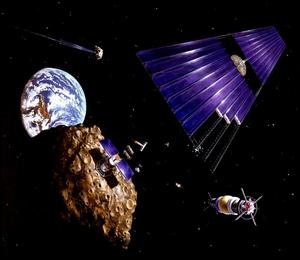
NASA, Artist concept by Denise Watt.
Mark Sonter, an Australian mining expert, has been active for years in the space community pursuing the potential of extracting resources from the asteroids, which he explains in a column at Space.com. The author begins by stating the two reasons humanity has to be interested in asteroids, particularly those that follow paths that cross Earth's orbit around the sun.
The Near Earth Asteroids offer both threat and promise. They present the threat of planetary impact with regional or global disaster. And they also offer the promise of resources to support humanity's long-term prosperity on Earth, and our movement into space and the solar system.
The variety of resources available in these objects is presented.
Spectroscopic studies suggest, and 'ground-truth' chemical assays of meteorites confirm, that a wide range of resources are present in asteroids and comets, including nickel-iron metal, silicate minerals, semiconductor and platinum group metals, water, bituminous hydrocarbons, and trapped or frozen gases including carbon dioxide and ammonia.
As one startling pointer to the unexpected riches in asteroids, many stony and stony-iron meteorites contain Platinum Group Metals at grades of up to 100 ppm (or 100 grams per ton). Operating open pit platinum and gold mines in South Africa and elsewhere mine ores of grade 5 to 10 ppm, so grades of 10 to 20 times higher would be regarded as spectacular if available in quantity, on Earth.
Sonter goes on to explain the economics of asteroid mining and the fact that lowering the cost of getting into space is key to opening up this enormous new industry. The tremendous impact this industry can have on the lives of human beings is illustrated by this citation of another space resources expert.
Professor John Lewis has pointed out (in Mining the Sky) that the resources of the solar system (the most accessible of which being those in the NEAs) can permanently support in first-world comfort some quadrillion people. In other words, the resources of the solar system are essentially infinite... And they are there for us to use, to invest consciousness into the universe, no less. It's time for humankind to come out of its shell, and begin to grow!!
Note: a 'quadrillion' is a one followed by fifteen zeroes.
Professor Lewis, a noted planetary scientist at the University of Arizona, explains in a profound way the social significance of this potential frontier industry in his book when he says
The best use of the wealth of the asteroid belt is...to expand our supply of the most precious resource of all - human beings.
Let me make a personal observation here. This blog may seem to readers as an eclectic mix of seemingly unrelated topics. However, as I say up top, my goal is to tie together various themes in a big picture view.
The 'conventional wisdom' of the human future is often portrayed as a situation of limited and diminishing resources requiring 'population control' (and all its lethal implications) to prevent some kind of global catastrophe. This dismal view of the future is flawed on several levels.
For one, population control efforts are often coercive, especially on the world's poorest people, and often divert aid money that should be spent on providing food, clean water, and medicine. Also, even before space resources are considered, human resourcefulness in developing the resources of this planet and using them more efficiently make the population alarmists' case seem rather dubious.
However, many foresighted people see human expansion into space and development of the resources and energy there as the long term positive alternative to the more dismal agendas. Protecting and providing for future generations is the moral imperative behind our expansion into space. Part of a culture of life is to take the long view, to take risks on the frontiers to provide for the lives of future human beings, each of whom have a unique God-given dignity.
No comments:
Post a Comment